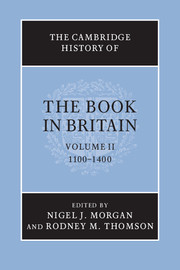Book contents
- Frontmatter
- Preface
- The roles of books
- Book production
- 3 The format of books – books, booklets and rolls
- 4 Layout and presentation of the text
- 5 Technology of production of the manuscript book
- I Parchment and paper, ruling and ink
- II Illumination – pigments, drawing and gilding
- III Bookbindings
- 6 Handwriting in English books
- 7 Monastic and cathedral book production
- 8 Urban production of manuscript books and the role of the university towns
- Readership, libraries, texts and contexts
- List of abbreviations
- Bibliography
- Photo credits
- General index
- Index of manuscripts
- Plates 1
- Plates 2
- References
III - Bookbindings
from 5 - Technology of production of the manuscript book
Published online by Cambridge University Press: 28 November 2008
- Frontmatter
- Preface
- The roles of books
- Book production
- 3 The format of books – books, booklets and rolls
- 4 Layout and presentation of the text
- 5 Technology of production of the manuscript book
- I Parchment and paper, ruling and ink
- II Illumination – pigments, drawing and gilding
- III Bookbindings
- 6 Handwriting in English books
- 7 Monastic and cathedral book production
- 8 Urban production of manuscript books and the role of the university towns
- Readership, libraries, texts and contexts
- List of abbreviations
- Bibliography
- Photo credits
- General index
- Index of manuscripts
- Plates 1
- Plates 2
- References
Summary
There are broadly three kinds of medieval book: first, books containing texts for reading and study (library books), secondly, books for use in a church or chapel for public or private devotion (liturgical books), and, thirdly, books containing records and business materials for reference and administration (archival books). Each kind of book had a different use, and this was often reflected in the manner in which each was made, used and housed, including the manner in which they were bound. However, the only kind of British books with medieval bindings that have been studied are library volumes, and few liturgical books with medieval bindings have survived at all. The number of archival books to have survived in medieval bindings is simply unknown, and very little has been written about those which have. Therefore almost everything below is concerned with library books that have survived with medieval bindings.
There are two kinds of medieval bindings: first, those whose quires were ‘sewn’ to ‘supports’ and enclosed in wooden boards covered with skin, usually manufactured by tawing (‘tawed skin’); secondly, those whose quires were either individually ‘stitched’ or sewn, and enclosed in a semi-stiff or limp covering, usually either of parchment or tawed skin. The purpose of both kinds of covering remained the same: a means of enclosing leaves of parchment made up into quires taking into account their hydroscopic nature, natural features and irregularities. In ‘stiff-board’ bindings the wooden boards acted like two platens, squeezing air from between the leaves when closed, to prevent them reacting to changes in the surrounding environment and to exclude dust.
- Type
- Chapter
- Information
- The Cambridge History of the Book in Britain , pp. 95 - 109Publisher: Cambridge University PressPrint publication year: 2008
References
- 43
- Cited by



